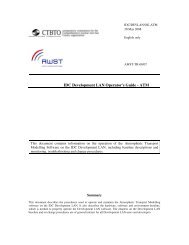ctbto Spectrum
ctbto Spectrum
ctbto Spectrum
Create successful ePaper yourself
Turn your PDF publications into a flip-book with our unique Google optimized e-Paper software.
Verification highlightsShipping supplies and personnel to palmer stationPhoto Courtesy of NSF/USAP by David Bresnahan, National Science Foundation.Windless Bight receives about 1.5metres of snow accumulation every year. Theequipment vaults where the microbarometersare located must, therefore, be dug out everyseason and replaced on top of the snow.Infrasound waves can generally penetratethe snow for several centimetres with littleattenuation (in the presence of attenuation,the signal becomes weaker over distance,i.e. with smaller amplitudes), but when thelayer of snow becomes too thick, the risk ofattenuation becomes higher. It is thereforealso necessary to dig the wind noise reducingsystem, which is connected to the equipmentvaults, out of the snow every year duringthe annual maintenance of the station.Communicating with thesouthernmost point on thesurface of the EarthWhile the Earth’s Polar Regions offerunique scientific research possibilities,their isolation and extreme climatesrender such opportunities extremelychallenging. The North and SouthPoles are the only places on Earththat cannot see geosynchronouscommunication satellites becauseof the distance from the Equator.In conjunction with the United StatesGeological Survey (USGS), the IMS operatesan auxiliary seismic station at the South Pole– AS114. This station providesdata on seismic events to theIDC to supplement informationgathered by primary seismicstations. By the time theIMS has been completed, atotal of 120 auxiliary seismicstations will have beencertified by the CTBTO.The issue of no satellitecoverage for up to 12 hoursa day needed to be addressedand the gap has now beenfilled by satellites belonging to the Iridiumnetwork. The Iridium network is a commercialconstellation of 66 communication satellitesthat circle the Earth on pole-to-pole orbitsat a height of 780 kilometres. The Iridiumnetwork is unique in that it covers the wholeEarth, providing communication coverageat the poles from where other satellites arenot visible. The CTBTO has collaboratedclosely with the USGS to develop thisservice, which has been heralded as abreakthrough in satellite communicationtechnology. Using this network and withthe support and assistance of USGS andNSF, AS114 has been able to transmitimportant seismic data from the South Polevia Denver to the IDC on a 24-hour basiswithout interruptions since February 2007.To facilitate operations, the IMShas provided AS114 with a special stationinterface computer so that it can respondto automatic data requests from the IDC.Despite the remoteness of the station andthe climatic extremes, AS114 has nowbeen fully integrated into the IMS.1,400 km sea voyage fromPunta Arenas to Anvers IslandRadionuclide monitoring station RN73 islocated at the United States owned PalmerStation on a protected harbour on the southwestern coast of Anvers Island off theAntarctica Peninsula. The station has beenC T B T O ’ s c o m m u n i c at i o n o f f i c e r o u t s i d e A s 11 4 at t h e s o u t h p o l e .pa g e 2 0 C T B T O S p e c t r u m 1 1 | S e p t e m b e r 2 0 0 8
















